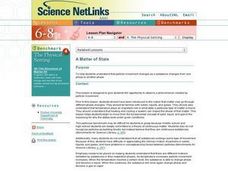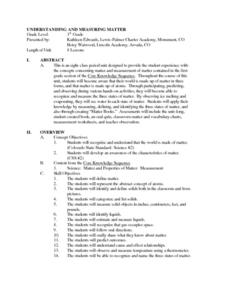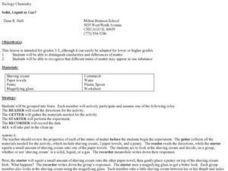Curated OER
To Float or Not to Float, That is the Question?
Ninth graders develop operational definition of density, do computations using density equation, categorize pieces of matter as being able to float on
water or not, based on density, explain why some objects sink or float based on...
Curated OER
It's Elemental, My Dear Students
Eighth graders research the structure of the atom. They identify the properties of subatomic particles, including mass and electrical charge. Students access the websit www.chem4kids and extract 10 main facts from the content provided...
Curated OER
Stream Ecology In Wisconsin and Puerto Rico
Students identify the different types of water and explain in what proportions they exist on Earth. They identify and correctly label the parts of the water cycle and how these parts interact with each other. Students identify the...
Curated OER
Waterproof Paper
Students explore matter through the concept of displacement. They perforrm an inquiry experiment with a glass, paper and a bucket to demonstrate that gases take up space.
Curated OER
Physical Properties of Matter
Students examine the physical properties of matter. They identify and classify a variety of objects based on their physical properties.
Curated OER
States of Matter
Learners discuss a given set of questions based on Chemistry and matter and review a glossary of terms. They conduct experiments on each state of matter: "Dry ice and water, Dry ice and soap and Dry ice and Isopropyl Alcohol." and...
Curated OER
Properties of Matter
Young scholars describe four states of matter and their characteristics, explain thermal expansion of matter, interpret state changes in terms of kinetic theory of matter, explain relationship between temperature and volume of a gas,...
Curated OER
What's the MATTER in our School?
While working in small groups, students use a digital camera to take pictures of various states of matter around the school grounds. Then they download the images onto the computer. The students then have to type or list the three states...
Curated OER
Solids, Liquids and Gases
Students are introduced to the various states of matter. After watching a video, they discover how to compare the three states using its shape and volume. In groups, they participate in an experiment with solids, liquids and gases and...
Curated OER
What State Are You?
Students identify three states of matter and recognize plasma as fourth state. They provide examples of matter that are classified in particular state and identify properties of each state of matter.
Curated OER
A Matter of State
Students conduct science experiments to understand that particle movement changes as a substance changes from one phase to another phase. Students record observations of experiments that involve the three states of matter: solid,...
Curated OER
Three States of Matter
Third graders investigate the three states of matter and the properties of materials as they undergo physical changes. They identify examples of each type of matter, role-play atoms in solids, liquids, and gases, and conduct an...
Curated OER
Science: Solids
Second graders investigate the properties of solids and discover how to classify them. Using rulers, they measure various solids on display. In groups, they play an identification game where one students names a location, such as the...
Curated OER
Classification
Students explore the observable properties of matter and utilize them in classification. They use a binary classification system to divide objects, then justify their scheme.
Curated OER
Classifying Candy I
Students explore the observable properties of matter. They develop two binary classification systems using concrete objects. based on two different properties of the concrete objects.
Curated OER
Plasma 101
Students examine the definitions and characteristics of plasma. After reading an article, they analyze new technologies to study plasma. In groups, they create a poster on how the different types of plasma work and write letters to their...
Curated OER
The Physical Behavior of Matter
Students distinguish between three phases of matter: solid, liquid and gas, on the molecular level. They compare and predict the relative compressibility of the three phases of matter through journal writings and drawings.
Curated OER
What's Matter?
Young scholars explore many of the basic properties of matter including atoms, ions, elements, molecules, and density. The class explores an interactive flash-animated Web site to answer questions and clarify misconceptions they might...
Curated OER
Household Chemistry
Young scholars use indicator paper to determine if substances are acidic, basic, or neutral. They test for Ph levels in them. They investigate the effect of oxygen on darkening fruit cut and exposed to the air. They observe vitamin C as...
Curated OER
Understanding And Measuring Matter
First graders observe ice melting and water evaporating. They experiment with sugar and water and read the poem "Matter Really Matters." They define vocabulary words and sing a matter song.
Curated OER
What's the Matter? (Grades 6-7)
Learners explain the physical properties of matter. They, in groups, perform a variety of experiments, each demonstrating a different property of matter. A very nice, hands-on lesson!
Curated OER
Energy and Changes of State
Young scholars complete a variety of labs to help them explain how energy affects the changes in states of matter. They also be required to collect and record data, graph data, and apply interpretations of that data.
Curated OER
Changing States: Does it Matter
Students participate in experiments to visualize the differences between chemical and physical changes. They attempt to detect the five characteristics of a chemical change.
Curated OER
Solid, Liquid, Or Gas?
Students identify physical characteristics and group objects for a picnic using the states of matter for each object and using literature to introduce the states of matter.

























